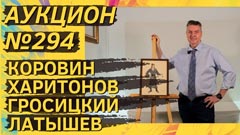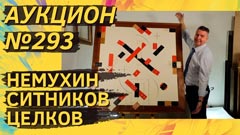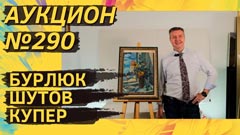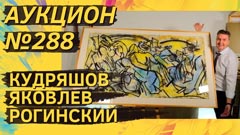
MASTERPIECES
SVESHNIKOV Boris Petrovich (1927–1998) Winter stop. 1980. Oil on canvas. 79 × 63
This painting of rare beauty comes from the collection of Piero Savoretti, the Italian entrepreneur who cut a window into the USSR and initiated the “contract of the century” to purchase the FIAT factory for Togliatti. The painting belongs to a particularly valuable inspired period. At the end of the 1970s Sveshnikov's palette becomes more dense and saturated. Connoisseurs note that in some works fantastic phosphorescent effect begins to appear, which will later disappear from his painting. And this is precisely our case. There is a mystical luminescence in “Winter Stop”, somewhat similar to Arkhip Kuindzhi's “Night over the Dnieper”. It is an amazing thing. The work is accompanied by the expert opinion of Valery Silaev with the assessment “has museum value”.
LEONOV Pavel Petrovich (1920–2011) Concert on the collective farm field. 1992. Oil on canvas. 102 × 152
“Concert on the collective farm field” by Pavel Leonov was for many years in the collection of Vitaly Patsyukov, a well-known art historian and ascetic. The painting is of museum size of a meter and a half and is in perfect preservation, something rarely seen in the works of Pavel Leonov in the 1990s. This is important, but in the first place — a successful plot and composition. Quite often in his paintings Leonov compresses the narrative, strives to tell as many stories as possible, fit 4–5 stories on one canvas. And here he is not going to spread. There are only three large figures in the foreground. The participants of this fantasy concert are characters from Russian fairy tales. Club-footed Bear, Nibbly-Quibbly the Goat... And in the distance — like at the hippodrome — carts driven by horses are rushing along. This piece has everything that is valued in Leonov's work. The atmosphere of a holiday, the fabulous plot, and the most powerful human optimism.
Today Pavel Leonov is a collectors' favorite and one of the most sought-after artists. But forty years ago, his fellow villagers considered the old man a “village madman”, pretending to be an artist. Pavel Petrovich was an object of ridicule, he was considered a crank, who invents a beautiful life for the collective farmers. For several years, the artist was afraid to paint and sell paintings, so that their own people did not say that he was engaged in speculation. He was afraid they would write a denunciation and he would go back to prison. His paintings would likely have been destroyed after his death. But fate decreed that the Moscow art historians became known about the village self-taught artist. His paintings ended up in museums and catalogs. And at the end of his life Leonov was lucky to catch the first rays of recognition. “Concert on the collective farm field” is certainly a museum level and an adornment to even the strongest collection.
1960s UNOFFICIAL ART
SLEPYSHEV Anatoly Stepanovich (1932–2016) Walk at sunset. 1980s. Oil on canvas. 80 × 100
It has everything that collectors expect from Slepyshev: a horse, a wandering traveler, and a red sunset. The only things missing are road poles going off into the sunset, and sagging wires, as he liked.
A one-meter spectacular piece that can pull an entire wall over itself.
Anatoly Slepyshev belongs to the orbit of unofficial art, was exhibited at the Izmailovo exhibition in 1974 and at the “House of Culture” at VDNKh in 1975.
ZVEREV Anatoly Timofeevich (1931–1986) Blue portrait. 1986. Oil on cardboard. 42 × 29.5
“Very good”, said Valery Silayev immediately, taking this work in his hands. An airy, textured portrait with a dominance of blue. Usually Zverev did portraits of such elaboration at special sessions, by invitation. Not for a “three-rouble note” on the first found piece of paper, but thoroughly, with preparation, with arrangement. In such cases, a client prepared in advance for maestro materials by list: factory cardboard and specified set of paints. Soon the bell rang and the action began. For Zverev, the client and the model were not simply clients, but spectators. The whole performance was staged for them. The artist worked quickly, masterfully, with a mood. Three to five minutes — and in front of an amazed audience appeared subtle and accurate portrait. “How? That's it?” “Yes, baby! Doesn't it look like it? Wait, it'll be like that soon”. Zverev enjoyed watching people's reactions. At such sessions, he was in his element. Who's in the blue portrait? We are unlikely to know. The wife of a diplomat or a correspondent. Probably someone on the diplomatic line, because the painting came back to us from Germany. The authenticity is confirmed by an expert report.
BORISOV Leonid Konstantinovich (1943–2013) Black and white. 1965. Wood, paint. Height with pedestal: 21 cm. Pedestal: 42 × 33
Signed and dated wood composition. Also a great rarity. Today we are witnessing almost the first appearance of Leonid Borisov's sculpture at auction. If his assemblages, paintings and ceramics can be found, finished sculptures are not. They are in museums, and in the hands of collectors of sculpture there are few.
“Black and white” is a conceptual thing. There is both the unity and struggle of opposites. There is the logic of “yin-yang”. There is the icon of Suprematism — the black square. There is also the constructivist conception. In a word, it is not a sculpture but a treasure trove of meanings.
It should be reminded that Borisov was a well-known representative of geometric abstraction, a St. Petersburg nonconformist and a figure in the Gazanevsky culture. The Soviet authorities considered him a slacker. An artist? Where did you study? At the Electrotechnical Institute? It's clear. Self-taught, that is. You're not a member of the Artists' Union and you don't work at the art factory? What kind of artist are you then! In order to avoid being expelled under a criminal article for parasitism, Borisov worked for a while in a boiler room. He was friends with Sokov, Shelkovskiy, Orlov, Koleichuk, Chuikov and others. In September 1975, he participated in a historical exhibition of independent art at the Nevsky Palace of Culture together with Zharkikh and Rukhin.
KRASNOPEVTSEV Dmitry Mikhailovich (1925–1995) Portrait of actress Elena Maivina. 1947. Oil on canvas. 59 × 48
This portrait is reproduced on p. 70 of the third volume of the catalogue “Dmitry Krasnopevtsev” compiled by Alexander Ushakov. Elena Grigoryevna Maivina was a famous actress of the Russian Drama Theatre of Lithuania. From the early 1950s she performed leading roles in the theatre's repertoire — Desdemona in “Othello”, Countess Vronskaya in “Anna Karenina” and many others. The actress died in 2008, buried in Vilnius. Discerning people pay attention to another feature of this portrait. One can guess the features of Krasnopevtsev himself in it. It is possible that the portrait became a kind of “Mona Lisa” of the artist. He encrypted the riddle in it, and at the same time he bid farewell to portrait realism on the eve of the advent of his metaphysical still life.
RUSSIAN ABROAD
BURLIUK David Davidovich (1882–1967) At the samovar. 1955. Oil on canvas. 20 × 26
The tea party scene was painted by the father of Russian futurism in 1955. Earlier the picture was in the collection of Ella Dreyfus, a longtime collector and friend of the artist. The authenticity is confirmed by the expert opinion.
CONTEMPORARY ART
SUROVTSEVA Elena Mikhailovna (1952) By the lake. 1982. Bronze, patina. Height 22 cm
- Log in to post comments










